Clematis Nelly Moser - how to grow properly
The ancient clematis Nelly Moser was bred by French breeders in 1897. It belongs to the Patens group - plants with large inflorescences. In our country, it is grown everywhere, since it has good winter hardiness. Consider the main characteristic of the vine, the rules for planting it and the features of its care.
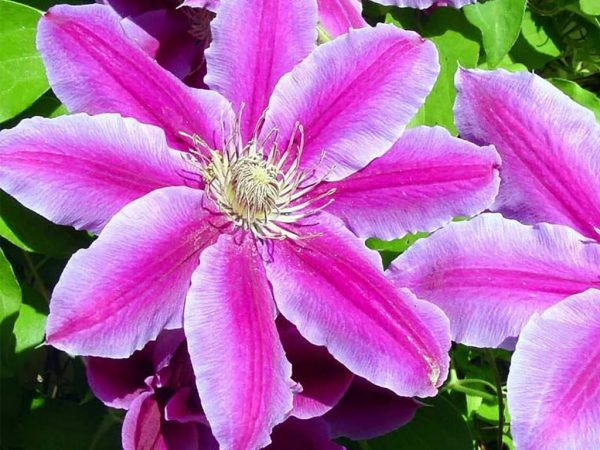
Clematis hybrid nelly moser
Description of the variety
Hybrid variety Nelly Moser - large-flowered clematis. The scientific name is clematis nelly moser.
The plant has good frost resistance and rarely gets sick with good care. Blooms twice a year: on last year's branches - from May to June. Then, on a young growth - from June to September.
The bush is compact, liana-like, up to 3 m high. The root system is massive, well-branched.
The growth force is average - up to 7-8 cm per year, but at the same time good bushiness - in one season the vine can release 15-17 young stems.
The stems are sinuous, dark brown. Leaves are light green, smooth, thin, oval in shape with a pointed tip.
The flowers consist of 8 petals, the circumference is 17-18 cm. The petals are pale lilac, almost white at the edges, there is a lilac-pink stripe in the center.
Landing rules
To achieve maximum decorative effect from clematis, you need to find a good place, soil for planting and provide the shrub with proper care.
The best time to plant seedlings is mid or late April. By this time, the bushes will not have time to awaken, but the soil will already warm up well and the last frosts will pass.
If the cultivation is planned in a warm or temperate climate, you can plant the vine in early autumn - before the beginning of October. 1-1.5 months before stable cold weather, they adapt and take root.
Places and soil
Hybrid clematis Nelly Moser prefers to grow in a shaded area with no sun at lunchtime. If planted in the sun, the plant will quickly lose its decorative effect - the leaves and inflorescences will dry out. It should be planted in a flower bed without stagnant water and drafts.
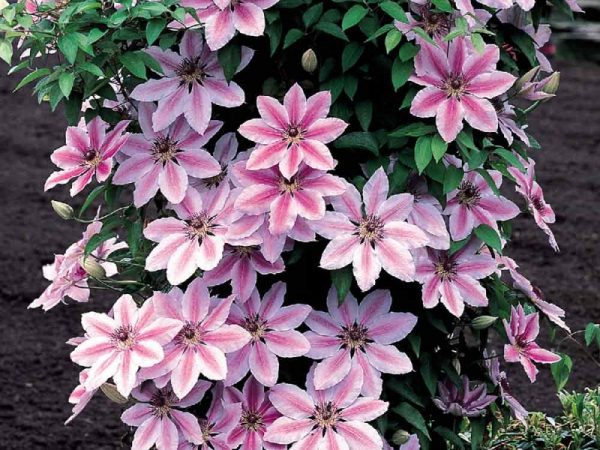
Clematis nelly moser
The liana is curly, so you need to plant it in an area where you can install a support. When planting near the walls of a house or outbuilding, it is worth making an indent of at least 50 m so that the root system can fully develop.
The soil is suitable for light, loose, enriched with minerals and organic matter. When planting on clay soil with a heavy structure, add sand, vermiculite or perlite per 1 m². When grown on sandy loam, the site is sprinkled with clay - 2 buckets for the same area.
Before planting, the place is cleaned of plant debris, weeds, then dug up and leveled.
Preparation of seedlings
The best planting material is considered to be annual seedlings with a closed root system in a container or with an earthen ball. You can buy them in a gardening nursery, 2 weeks before the planned disembarkation.
When choosing, carefully inspect the crown so that it does not have mechanical injuries, signs of infection.
During this time, the bushes are spilled with Fitosporim every 7 days. Also, the near-trunk zone is irrigated with this solution. This will help disinfect the shipping soil and protect against infection.
The buds that have appeared must be cut off, since they take away the strength and energy of the plant, which can negatively affect the survival rate.
The plant is removed from the pot and, together with a lump of earth, is placed in a container of water for two hours. The roots are then pruned 2 to 3 cm in length to stimulate rapid establishment and growth.
Landing technology
When planting in groups, pits are pulled out at a distance of 1 m so that the seedlings can fully develop and receive the required amount of light, moisture and nutrients.
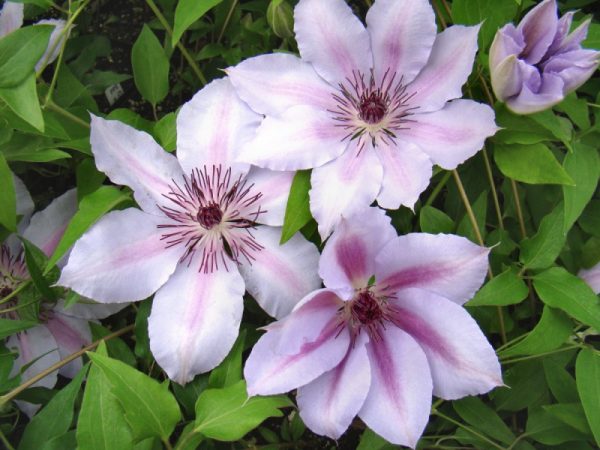
Clematis nelly moser photo and description
The approximate parameters of the landing holes are 50x60 cm. 15 cm of drainage (pebbles, gravel or brick chips) is laid in the pit to ensure a good outflow of excess moisture in the future.
If the soil is acidic, then it needs to be limed. When planting, mix the dug earth with compost (humus) and 200 g of wood ash. The nutrient composition is slightly trampled, a hole is pulled out in the center, an earthen lump with a rhizome is placed in it, covered with soil mixture to the top, compacted.
Deepening of the root collar to 10-12 cm is allowed if all the shoots of clematis are lignified. If there is a young growth in the root zone, then you should not immediately deepen it, otherwise the green stems will rot. This can provoke the appearance of diseases on the roots and crown.
After planting, the seedling is watered, a support is installed next to it, and tied up. To avoid drying out the soil, mulch with sawdust, peat or coconut fiber. Also, mulch will protect the superficial root system from overheating.
Care requirements
For a month, the seedlings need shelter from the scorching sun - they are shaded with agrofibre or burlap at lunchtime.
In the near-trunk zone, you can plant low-growing flowering plants - calendula or marigolds. They will serve as additional protection against drying out of the earth, and will also repel harmful insects.
Large-flowered clematis needs periodic moistening, loosening, pruning and feeding.
Watering
For quick rooting and building up green mass in the first month, the bush is watered daily, provided that the summer is dry. 5 liters of water are added under each bush. Further watering is carried out as the soil dries up to 5-6 cm.
The obligatory ones need to be watered in early spring, before flowering, after it and in the fall, when the vine will drop all the foliage.
So that a crust does not form on the surface of the soil, a day after moistening, light loosening is required to a depth of 5-6 cm. Then mulch is added from sawdust, peat or humus. The covering layer will protect against rapid evaporation of moisture.
In extreme heat, clematis should be sprayed with warm water so that it does not dry out. Additionally, irrigation prevents the appearance of spider mites. The procedure is carried out in the evening when the sun goes down and no more than once every three days.
Top dressing
In the first two years, feeding is not needed, the seedlings have enough nutrients that were laid down during planting.
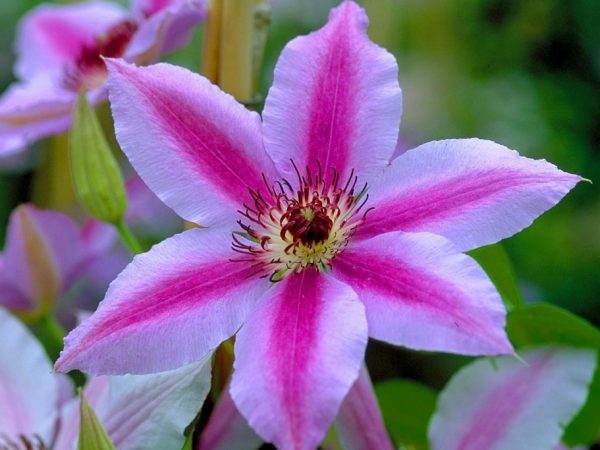
Clematis nelly moser
Further, for intensive growth of young growth, the liana is fed with nitrogen-containing preparations - a solution of urea, nitrophoska or nitroammophoska - 15 g is dissolved in 10 liters of water. Consumption per bush - 5 liters.
During the development of buds, it is worth spilling a solution of superphosphate with potassium sulfate - 1 tbsp each. l. on a bucket of water. The same remedy is fed after the end of flowering.
Reacts positively to food with wood ash (200 g) and ammonia (1 tbsp. L.) In a bucket of water. Fertilize three times per season - in early spring, at the beginning of flowering and in autumn after the inflorescences dry out.
To improve the quality of assimilation of nutrients, fertilizers are combined with irrigation.
Pruning
This clematis variety belongs to the second pruning group - flowering occurs on old overwintered branches in spring, then in summer on young ones. The haircut is carried out in two stages:
- The first after flowering in June. Cut off the part that has faded or completely to the base in order to thin out the bush a little.
- The second time in the fall - a young growth with dried buds is shortened to a length of 30-50 cm.
Additionally, all broken off and shrunken parts are cut out. After pruning, the crown is treated with copper sulfate.
Preparing for winter
As soon as the soil freezes to a depth of 3-5 cm, they begin to warm the shrub. First, the near-trunk zone is mulched with a mixture of peat and sand. The shoots are neatly folded into loops, bent to the ground, covered with a non-woven material, and fixed with staples or hairpins.
They remove the insulation in the spring, when the snow thaws and the threat of return frosts has passed.
Reproduction methods
By dividing the bush
This method is used for old bushes that have stopped growing or bloom poorly, as well as for specimens with damaged roots.
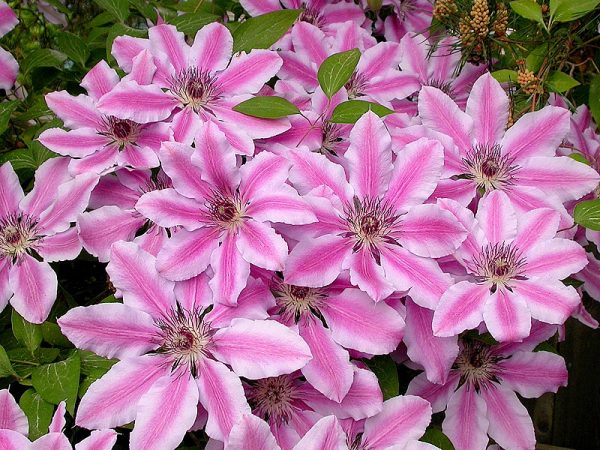
Clematis nelly moser planting and leaving
The liana is watered abundantly, after an hour it is dug in, removed and, together with a lump of earth, is lowered into a basin of water to wash off the remnants of the soil.
The rhizome is dried, if necessary, all diseased fragments are cut out, cut into pieces. Each delenka must have roots, at least one stem with buds. Places of cuts are sprinkled with crushed charcoal, then seated separately.
Stem layering
The most effective and simplest method used in the fall. Choose a flexible lignified twig growing close to the ground on an adult bush. Remove all the leaves on it. It is lowered into a groove dug next to it to a depth of 5-6 cm. Sprinkle with a mixture of peat sand and leaf compost, mixed in equal amounts.
On the eve of autumn frosts, they fall asleep with fallen leaves, and spruce branches are laid on top. Such insulation will protect the layers from freezing in winter.
In the spring, when the snow thaws, the heat of the street stabilizes, the twig is dug up. Cut from the mother plant, divide it into several segments so that each has roots. They are seated separately in the garden or flower garden.
Cuttings
You can dilute clematis with green cuttings. At the top, several stems with leaves, buds and one internode are selected. In the lower part, the foliage is cut off, dipped in Kornevin's solution for half an hour.
They are planted in a mixture of peat and sand to a depth of 3-4 cm. Water, cover with foil, put in a warm and well-lit place.
It can take 2 to 3 weeks for rooting. During this time, the seedlings are ventilated every day, as the substrate dries, they are moistened.
As soon as they release new leaves, the film can be removed. After a month of home growing, they are transplanted into open ground.
Diseases and pests
The appearance of diseases on the crown or roots is possible if the rules of agricultural technology are violated.
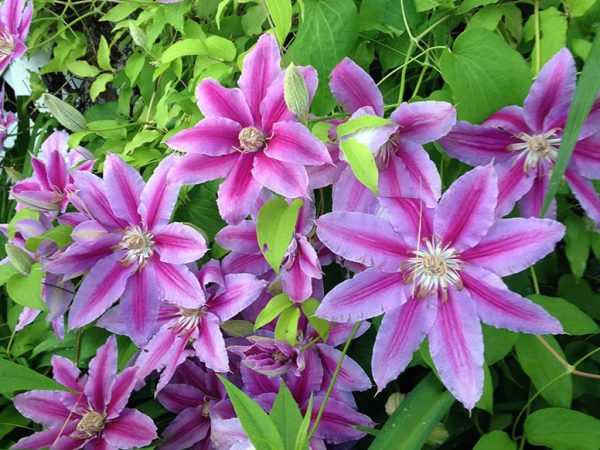
Clematis grandiflorum nelly moser
- Wilt (wilting). A dangerous fungal disease that appears during the period of active flowering and growth. Signs - rapid loss of turgor on the leaves and stems. It is not subject to treatment, so the bush is dug up and disposed of. The soil is spilled with a solution of copper sulfate.
- Rust. Red or brown shapeless growths on all organs are a sure sign of infection with this sore. Infected places darken, die off, the bush stops growing and gradually withers away. First, the damaged tissue is removed, then the crown is irrigated with Bordeaux liquid of 2% concentration.
- Powdery mildew. The appearance of a whitish bloom on foliage and flowers. Liana stops growing, loses its decorative effect. The treatment is as follows - diseased organs are cut out, the aerial part is treated with a solution of 30 g of copper sulfate, 300 g of crushed laundry soap and 10 liters of water.
- Ascochitosis (leaf spot).First, brown spots appear in the center and at the edges of the leaves, over time they become dry, brittle, holes form on the surface. The infected parts are removed, the crown is sprayed with copper sulfate.
- Gray rot. Shoots and foliage are covered with brown spots with a grayish bloom. This infection spreads very quickly and therefore requires urgent treatment. The shrub is treated with Fundazol solution twice with an interval of 10 days.
- Of the pests, aphids and spider mites are annoying. In the fight against insects, insecticides are used - Karbofos, Aktellik, Aktaru or Fitoverm. Also on the crown you can find slugs and snails, which do no less harm. To avoid their appearance, the trunk circle is sprinkled with coniferous sawdust or wood ash.
To preserve the decorativeness and health of the shrub, it is necessary to follow a number of simple preventive measures:
- buy strong seedlings;
- avoid thickening when planting;
- loosen the soil regularly, keep the flower bed clean;
- cut out the diseased parts in time;
- in early spring and late autumn, treat with a solution of copper sulfate or Bordeaux liquid.
Application in landscape
Clematis Nelly Moser are widely used in landscape design:

Clematis nelly moser trimming group
- grown as a tapeworm, planted in combination with other varieties to create a multi-colored curly composition;
- used for landscaping gazebos, arches, terraces, pergolas and other vertical surfaces;
- planted along fences in combination with low-growing plants - hosts, heather, marigolds, calendula.
Testimonials
For gardeners, this variety is especially valuable, since it is considered unpretentious and frost-resistant:
- Many fell in love with it for its successful reproduction - you can independently grow new bushes from a purchased seedling. In addition, they retain all the varietal characteristics of the parent plant.
- They tolerate well the neighborhood of any decorative vegetation, which allows you to create the most unusual and original composition in the garden.
- If clematis is given proper care, it will bloom for a long time and will not be damaged by diseases and pests.

